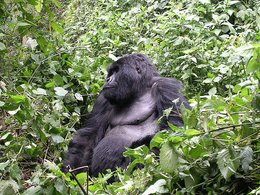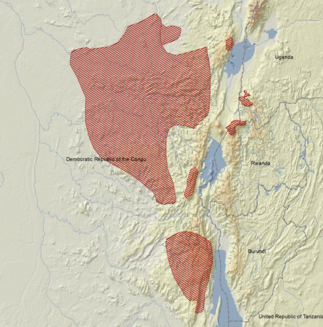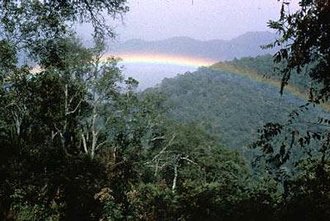Eastern Gorilla
Contents
Eastern gorilla
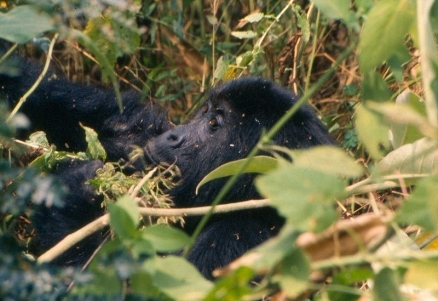
The Mountain Gorilla (Gorilla beringei beringei) is one of the two subspecies of the Eastern Gorilla. There are two populations, one is found in the Virunga volcanic mountains of Central Africa, the other in Uganda's Bwindi Impenetrable National Park. this photograph was taken in Virunga National Park in the eastern Democratic Republic of Congo (DRC). (Source Ad Meskens, via Wikimedia Commons)
The Eastern Gorilla (scientific name: Gorilla beringei) is one of two species of gorilla in the family of species known as Hominidae or "Great Apes." Hominidae include humans, chimpanzees, orangutans as well as gorillas. After chimpanzees, gorillas are the closest relatives of humans.
Eastern gorillas are found in central Africa in the eastern part of the Democratic Republic of the Congo (DRC) and in the western parts of Uganda and Rwanda near the DRC border.
The largest of the living apes, the gorilla has a characteristically heavy body shape, with broad chests and long arms, and a shaggy dark coat. Gorillas are quadrupedal, walking on the knuckles of their forelimbs and the soles of their feet. Until recently all gorillas were considered to belong to single species, but there is now wide aceptance that the populations in western and central Africa are distinct species, each with (this may be changed) two subspecies.
The two indentified subspecies of Eastern gorilla are the critically endangered Mountain gorilla (Gorilla beringei beringei) and the more common, but still endangered, Eastern lowland gorilla or "Grauer's gorilla" (Gorilla beringei graueri.)
| Conservation Status |
|
Kingdom: Animalia |
The International Union for the Conservation of Nature and Natural Resources (IUCN) reports that there are only about 300 mature adult Mountain gorillas (the entire population is estimated to be about 680 - 720 individuals). After decades of decline, the numbers of this subspecies appear to have increased slightly in recent years. However, if this increase is real, it it likely occuring among a small number of gorilla groupsin highly protected areas of rich ecology.
The number of Eastern lowland gorillas is larger but has suffered a rapid decline due to the wars and civil conflicts that have occurred in areas where they live in the eastern part of the DRC along with poaching and encroahment by humans on the gorilla's habitat. A 1995 estimate put their numbers at 16,900, while a 2004 study by Conservation International estimated that their numbers had dropped to 5,000 or less.
Eastern gorillas live in stable, cohesive family groups, led by a dominant silverback male. Eastern gorillas tend to have larger group sizes than their western relatives, exceptionally numbering more than 50 individuals. There is no distinct breeding season and females give birth only once every three to four years due to the gestation period of 8.5 months and a long period of parental care. Newborn gorillas have greyish-pink skin and can crawl after nine weeks; they are not fully weaned until 3.5 years. Males defend their females and offspring using their large size in intimidating displays involving charging and chest-beating.
Eastern gorillas are herbivorous, with a heavily foliage-based diet. They have smaller home ranges than western gorillas as foliage is more abundant than fruit. They are diurnal but most foraging occurs in the morning and late afternoon. At night they build nests by folding over vegetation, usually on the ground.
Physical Description
%2c_Parc_des_Volcans%2c_Rwanda.jpg) Distribution of Eastern Gorillas. The line of lakes reveals the Albertine rift with the DRC to the left and Uganda, Rwanda, and Burundi to the right. The two smaller shaded areas in the middle right are the two populations of Mountain gorillas, while the other areas indicate the Eastern lowland gorilla. Source: IUCN
Distribution of Eastern Gorillas. The line of lakes reveals the Albertine rift with the DRC to the left and Uganda, Rwanda, and Burundi to the right. The two smaller shaded areas in the middle right are the two populations of Mountain gorillas, while the other areas indicate the Eastern lowland gorilla. Source: IUCN Gorillas are the largest primate, with average lengths of 150 cm (4' 11") for females and 185 cm (6' 1") for males. They are sexually dimorphic, with females weighing 70 to 114 kg (154 - 251 lbs) and males averaging 160 kg (353 lbs). In addition to being much larger than females, mature male gorillas have a large skull crest.
They have robust bodies, long muscular arms, short legs, massive heads, and males have large, sharp canine teeth.
Mountain gorillas and Eastern lowland gorillas differ subtly in a number of ways. Mountain gorillas are slightly larger, have longer hair, larger cranium, broader facial skeleton, larger jaws and teeth, and less round nostrils.Mountain gorilla coats are silky and long, ranging in color from blue-black to brownish-grey.
Evolutionarily, these two subspecies are estimated toseparated about 400,000 years ago.
At about 14 years old, the hair in the saddle of the backs of Eastern gorilla males turns white and hence they are known as 'silverbacks'.
Males also have apocrine glands in their armpits that emit a strong odor when the animal is under stress.
Behavior and Reproduction
The behavior of eastern gorillas, particularly Mountaintain gorillas, have been studied closely for many years. Centers like the Karisoke Research Center inside Rwanda's Volcanoes National Park (established by Dian Fossey in 1967) have provided a long term capacity for the careful study of these animals.
Eastern gorillas live in three three types of groups:
- Single male groups are the most common social unit, with the male has a harem of usually 3-4 females and their offspring, with a total of eight to eleven indivuals being common. In this polygynous arrangement the dominant male in each group has exclusive access to all the female. These groups are non-territorial, but severe intergroup conflicts can occur when groups encounter each other and especially if a lone male contacts the group. The dominant male of a group is massive compared to the other members and they all defer to him.
- Multi-male groups with females account for about 10% of groups in Eastern lowland gorillas and a higher percentage amount Mountain gorillas (up to half in some areas at some times). These groups have an a overall dominant male who has access to all or most of the females; but subordinate males still have mating opportunities and can succcesfuly have off-spring. Multi-male groups are very rare with Western gorillas and the commonality of the them among Eastern gorillas is a notable difference between the two species. These types of groups can become much larger (one observed group reached 65 members at one point, but this was exceptional.)
- Multi-male groups without females can form with males too young to establish their own group.
A 2000 study of Mountain gorillas in the Virungas counted 359 individuals of an estimated total population of 395. There were 32 social groups of which just over half were multi-male. The average group size was eleven. There were ten solitary males. Just under half the population were immature individuals.
Females seem to have independence and will leave a group to join another or a single male if they find life in their group unacceptable. Thus, there seems to be strong motivation for dominant males to create an good life for the females in his group. Like human social groups, the dynamics within gorilla groups are dynamic and have complicated inter-relationships.
When a dominant male dies, a group without other males may disintegrate and the females with attach themselves to other group. In a multi-male group a subordinate male will usually assume leadership. Even before a male dies, he may find his leadership challenged from inside a multi-male group or from outside a single-male group.
Males often leave the natal group at around 11 years of age. Males, however, can't join an establish group, and they spend much time in solitary existence until they can gain females and begin a group of their own and start breeding at age 15 or older.
Among the Mountain gorillas of Virungas, females become sexually mature at about six-and-a-half years, but do not became able to conceive for another two years, during which they are termed "sub-adult." Females transfer from their natal group to a new group before breeding. This generally occurs at around 8 years of age. Often they join a lone male and start a new group, rather than join an established group and be a lower ranking female.
Reproductive rates are slow and a female may leave only 2 to 6 offspring over a 40 year life-span. Reproductive output for females is about one surviving offspring every 8 years (survival implying the offspringreaching breeding age). Males that have harems of 3 to 4 females increase their reproductive output by fathering 10 to 20 offspring over 50 years.
Mating behavior is initiated by the female, with a series of slow and hesitant approaches to the male. A female is receptive only during estrus, and she will cease to ovulate for several years after giving birth. The length of the estrous cycle of a female mountain gorilla is 28 days, and there is no visible external menstrual flow.
A single, dependent young is born after a eight and a half month gestation period. Weaning often doesn't occur until three years of age, and juveniles may remain with mothers for years after that.
Females provide most of the parental care in this species. Females nurse and carry their young for about 4 years. They also play with the young, teach them, and groom them. Grooming often occurs between females and males, or among females.
The role of males in parental care is less direct, although no less important. Males protect the females and the young within their social group from potentially infanticidal rival males who may try to take control of the group. Infanticide, when it occurs, is thought by many to be motivated by new dominant males seeking to speed up their sexual access to females by killing an infant rather than waiting for it to be weaned (during which time the mother is not fertile.) The frequency and motivations for infanticide among gorillas is a topic on ongoing discussion among primatologists.
Gorillas spend about 30% of the day feeding, 30% traveling, and 40% resting.
Each night, gorillas make nests in which to sleep and rest. The Mountain gorillas in the Virungas mostly build nests on the ground, while Eastern lowland gorillas in lowland tropical forests build their nests in trees about half the time. Eastern lowland gorillas in higher altitude montane forests use trees less frequently.
Gorillas can reach ages of 40 to 50 years.
Communication
All primates have complex patterns of communication. Gorillas are known to use vocalizations to communicate with one another. Silverbacks will use barks, hoots, roars, screams are used in a situation of escalating tension such as the presence of an outside silverback. Vocalizations can be accompanied by thumping the ground, beating the chest, and charges toward the outside threat. Other situations have their own types of vocalizations. Vocalizations are also related to a a gorillas position within a group. Sometime vocalizations are part of an exchange with one or more others in the group, but most vocalizations elicit no response and it is unclear what meaning they have. Tactile communication, in the form of grooming, play, and sexual contact, also occurs. Males emit a strong odor when stressed, which appears to function as a type of chemical communication. In addition to these, gorillas use body postures and facial expressions, as well as other visual signals, to communicate with one another.
Distribution
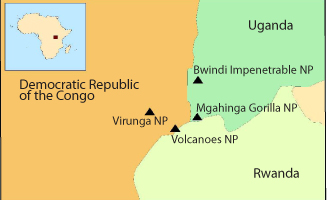 Bwindi Forest, Uganda (Source: Photograph by WWF/T.Bulynski)
Bwindi Forest, Uganda (Source: Photograph by WWF/T.Bulynski) Eastern gorillas are found in central Africa in the eastern part of the Democratic Republic of the Congo and in the western parts of Uganda and Rwanda near the DRC border.
The Eastern Lowland Gorilla is endemic to 21,600 km2 in the eastern part of the DRC (a decline of 25% in the past 50 years.) It is found in disconnected areas east of the Lualaba River and west of the Albertine rift, and from the northwest corner of Lake Edward in the north, to the northwest corner of Lake Tanganyika in the South. The southern limit of the current Eastern Lowland Gorilla range has been extended by the discovery in late 2007 of a hitherto unreported population in the Hewa Bora region east of Kilembwe in Fizi District."
Important protected areas in region include: Maiko National Park, Usala Gorilla Reserve, Tayna Gorilla Reserve, Kisimba Ikobo Nature Reserve (with Bakumbule Primate Reserve), Bakano Forest Reserve, Kahuzi-Biéga National Park, and Massif d'Itombwe Nature Reserve, Punia Gorilla Reserve, Maniema Forest Reserve, and Luama Game Reserve. A new community reserve is being planned for the Masisi region south of Virunga National Park.
The approximately 700 surviving mountains gorillas are found in two isolated populations in the Albertine rift area that overlaps the borders of Rwanda, Uganda and the DRC.
One Mountain gorilla population is found in a 440 km2 area of the Virunga Mountains/Virunga Volcanoes region where three national parks that connect at the border of the three nations and form one area: Mgahinga Gorilla National Park in Uganda; Virunga National Park in the DRC; and, Volcanoes National Park in Rwanda.) These parks include most of the remaining forest in the area.
The second Mountain gorilla population is found inthe 330 km2 area of theBwindi Impenetrable National Park in in southwestern Uganda. There is an ongoing discussion among scientists about whether the Bwindi population of 300-320 individuals should be considered a separate and third subspecies of theEastern gorilla.
Habitat
The eastern gorilla inhabits tropical forest near the equator. Mountain gorillas are found at altitudes between 1,160 and 4,100 metres while eastern lowland gorillas occur between 600 and 2,900 metres above sea level.
The Eastern lowland gorillas occupy Northeastern Congolian lowland tropic rain forests (500 m altitude) east of the Congo River which rises to the west through transitional forests toAfromontane habitat(2,800 m altitude) in themountains on the western edge of the Albertine rift.
Mountain gorillas of the Virunga Vocanoes inhabit the montane cloud forest that are part of Albertine Rift montane forests ecoregion at altitudes ranging fromof 1,500 m to 3,600 m altitude.In the low elevations of the Virungas, forests of bamboo provide cover for mountain gorillas. At altitudes above 3,500 m, montane rainforest grades through Juniper forest and Ericaceous Heathland into the tussock grass and Giant Lobelia dominated altimontane vegetation of the Ruwenzori-Virunga montane moorlands.Occasionally the gorillasgo into the afro-alpine meadows (4,000 m) where temperatures are subfreezing at night and there is little suitable food to forage on.
Mountain gorillas in the Bwindi Impenetrable National Park (1,100 m - 2,400 m in altitude) are in hilly, mixed forest habitat with a desnse understory.
Food & Feeding Habits
Mountain gorillas occasionally eat invertebrates, but they are primarily folivorous. They eat the roots, leaves, stems, and pith of herbs, vines, shrubs, and bamboo. Their diet is supplemented by small amounts of bark, wood, roots, flowers, fruit, fungi, epithelium stripped from roots, galls, invertebrates, and gorilla dung. Their diet varies withaltitude and vegetation. For example, the Mountain gorillas in the Bwindi Impenetrable National Park include a lot of fruit in their diet.
Eastern lowland gorillas have a somewhat more varied diet with more fruit than mountain gorillas and supplementing plant food like leaves, stems, and seeds with insects like ants and termites. At higher altitudes, the diet of Eastern lowland gorillas begins to look a little more like that of Mountain gorillas with fewer insects and more baboo.
Threats & Conservation Status
The Easterngorilla is classified as Endangered (EN) on the IUCN Red List, and listed on Appendix I of CITES. This is due both to habitat destruction and severe poaching pressures. The Mountain gorilla subspecies is classified as Critically Endangered because of its small population, limited habitat, the pressures on that habitat, and threats to animals.
A 1995 estimate of the population of eastern lowland gorillas put their numbers at 16,900, while a 2004 study by Conservation International estimated that their numbers had dropped to 5,000 or less. The Virunga population was estimated to comprise 380 individuals in 2003, while there were estimated to be just 300 individuals in the Bwindi population in 2006. Today estimate of population vary, but typically fall in the range of 680-720 individuals total.
Gorilla species are subjected to heavy pressure from poaching for bushmeat, body parts and for young animals collected for zoos and private collections, generating illegal income. The mountain gorilla occurs mainly within national parks and in some areas is protected by armed guards to prevent poaching.
One of the greatest threats to the Eastern gorilla is the conflict that has raged in the area for over a decade. The resultantmovements of refugees and malitias, and breakdown ofauthority,has put pressure on those protecting gorilla areas, and directly on gorillas who can be killed in crossfire or find find their habitat degrade by people in need of firewood or something else. In the mid 1990's, the number of Eastern lowland gorillas in Kahuzi-Biéga National Park was estimated to be about 8,000; today the number may be a low as 1,000, accounting for most of the drop in the overall population of Eastern gorillas. In 2007 eight Mountain gorillas in Virunga National Park in the DRC were killed.
Even without the ongoing civil conflict, pressures on gorilla habitat are significant. In both Rwanda and Burundi there are very high human population densities and in many areas the only stands of forest remaining are within Forest Reserves or National Parks, or those stands found in the most mountainous and therefore inaccessible areas.
In Uganda, a similar situation occurs, where forest habitat has been lost from the majority of areas that are not protected by National Parks or which do not have Forest Reserve status.
However, in the more eastern and southern portions of the Itombwe Mountains in the Democratic Republic of the Congo, the population density is lower, and far greater areas of forest exist, including complete transition zones between lowland and montane forest types. There remains a worry that some of these areas may be logged and this should form a focus of any future conservation initiatives within the ecoregion. However, on each mountain block within the range the habitat has also been fragmented through the activities of man, specifically subsistence farming. Probably the least fragmented and most extensive area of habitat is found within the Itombwe Mountains of the Democratic Republic of the Congo. In other areas, the forests are typically confined within protected areas, with the land between these areas largely farmed and occupied by people.
Eastern gorillas, particularly Mountain gorillas are very popular withecotourists. This industry provides jobs and revenue to the local economy and incentives for the continued protection of habitat. However, close proximatey to humans carries the risk of disease transmission to the gorillas and unintended impact on their habitat. Studies have shown that, on balance, gorillas visited regularly by ecotourists fare better that others; probably because they receive greater monitoring and protection.
Due to the high population density in the areas surrounding Mountain gorillas in particular, and continuing population growth, some people feel that the land would be better put to higher commercial use for humans throughconversion to agriculture or ther uses.However, ecotourism, the high international visibility of gorillas, particularly Mountain gorillas (achieved byindividuals such as scientist Dian Fossey with her book Gorillas in the Mist), and numerous conservation initiatives, many of which recognize the importance of localhuman education and development as a part of gorilla protection, makes alternative uses of national parks unlikely. Though other areas are more vulnerable to encroachment.
These animals are very large, and live in regions where not many potential predators, other than humans, exist. It is not likely that they fall prey to any particular species with any regularity.
Research and Conservation
Because of their isolation, the scientific study of Eastern gorillas is a relative recent endeavor. Geoge Schaller undertook a two-year study of Mountain gorillas in 1959 resulting in The Mountain Gorilla: Ecology and Behavior (1963) and the more recent The Year of the Gorilla (1997). Dian Fossey undertook a far long and more comprehensive study first in the DRC in late 1966, before moving to Rwanda in the following year where she established the Karisoke Research Center. From there she studied the local Mountain gorillas for eighteen years until she was murdered in 1985. The Center continues is scientific and conservation work to the present under as part of the Dian Fossey Gorilla Fund International.While these two scientists are perhaps the most famous, many others have contributed significantly to the study of these animals.
Local scientific capacity has increased significant in the last two decade. For example, the Institute of Forest Tropical Conservation at Mbarara University in Uganda has significant program of reserach in Impenetrable National Park] and Makerere University Institute of Environment and Natural Resources is also active. Government agencies are also important particpants in scientific work including, Uganda's National Forest Authority and Wildlife Authority,
Most international organizations active in the area, like the Africa Wildlife Foundation, Wildlife Conservation Society, World Wildlife Fund undertake a combination of scientific and conservation work. For example, the Wildlife Conservation Society's program includes scientific monitoring and surveying with capacity building of national organizations and support to management activities in parks and other protected area.
Conservation program generally recognize the importance of address the related issues of human development in the communities near gorilla habitats. Ecotourism is widely supported as a way of bringing jobs, dollars and appreciation for the gorillas and their habitats to local communities.
While eastern gorillas are one of the most well recognized and charismatic species in the world, and organizations dedicated to their protection receive greater support than those dedicated to many other environmental concerns, they are still one of the most imperiled species. Their small numbers and fractured habitat, combined with systemic outside pressures from local human needs for resources and development, and (tragically not so transient) pressures from wars and civil conflicts, make the future of Eastern gorillas very uncertain.
Further Reading
- Gorilla beringei, Encyclopedia of Life (accessed June 13, 2009)
- World Atlas of Great Apes and Their Conservation],Julian Caldecott and Lera Miles (Editors), University of California Press, Berkeley, 2005. ISBN: 0520246330.
- Gorilla beringei, Lindsley, T. and A. Sorin. 2001. Animal Diversity Web. (accessed June 12, 2009)
- Eastern Gorilla, ARKive (accessed June 12, 2009)
- Mountain Gorillas: Biology, Conservation, and Coexistence by Gene Eckhart and Annette Lanjouw,Johns Hopkins University Press, 2008 ISBN: 080189011X.
- In the Kingdom of Gorillas: Fragile Species in a Dangerous Land by Bill Weber and Amy Vedder, Simon & Schuster, 2002 ISBN: 0743200071.
- A history of gorilla taxonomy by Colin Groves in Gorilla Biology: A Multidisciplinary Perspective, Andrea B. Taylor & Michele L. Goldsmith (editors), Cambridge University Press, 2003 ISBN: 0521792819.
- Albertine Rift Programme, Wildlife Conservation Society(accessed June 17, 2009)
- The Behavior Guide to African Mammals by Richard Despard Estes, University of California Press, 1992 /?tag=encycofearth-20 ISBN: 0520080858.</span> </span></li>
- Mittermeier, Russell A. and Dorothy L. Cheney. 1987. Conservation of Primates and Their Habitats. Primate Societies. 189- 202. </li>
- Watts, David P. 1994. Agnostic relationships between female mountain gorillas. Behavioral Ecological Sociobiology, vol.34. 347-358.</li>
- Watts, David P. 1990. Ecology of gorillas and its relation to female transfer in mountain gorillas. International Journal of Primatology, vol.11. 21-43.</li>
- Stewart, Kelly J. and Alexander H. Harcourt. 1986. Gorillas: Variation in Female Relationships. Primate Societies. 155-164. </li>
- Blaffer Hrdy, Sarah and Patricia L. Whitten. 1986. Patterning of Sexual Activity. Primate Societies. 370- 384.</li>
- IUCN Red List (accessed June 13, 2009) </li>
- Williamson, E.A. and Butynski, T.M. (2009) Gorilla gorilla. In: Butynski, T.M. Ed. The Mammals of Africa Volume 6. Elsevier Press, in press </li>
- CITES (February, 2009) </li>
- Gorillas, WWF Threatened Species Account (February, 2009) </li>
- Snares and Scares, Gorilla Doctors (February, 2009) </li>
- Mountain Gorilla Threats, WWF Threatened Species Account (2008) </li>
- Williamson, E.A. and Fawcett, K.A. (2008) Long-term research and conservation of the Virunga mountain gorillas. In: Wrangham, R. and Ross, E. Eds. Science and Conservation in African Forests: The Benefits of Long-term Research. Cambridge University Press, Cambridge, UK, 2008 ISBN: 0521896010. </li>
- Great Ape Survival Project (accessed June 13, 2009) </li>
- Uganda's Mountain Gorillas Increase In Number Science Daily, April 27, 2007</li>
- Institute of Forest Tropical Conservation, Mbarara University, Uganda </li>
- The Mountain Gorilla: Ecology and Behavior by George Schaller, University of Chicago Press, 1963 </li>
- The Year of the Gorilla by George Schaller, University of Chicago Press, 1997ISBN: 0226736482. </li>
- Gorillas in the Mist by Dian Fossey, Mariner Books, 2000 ISBN: 061808360X. </li></ul>
